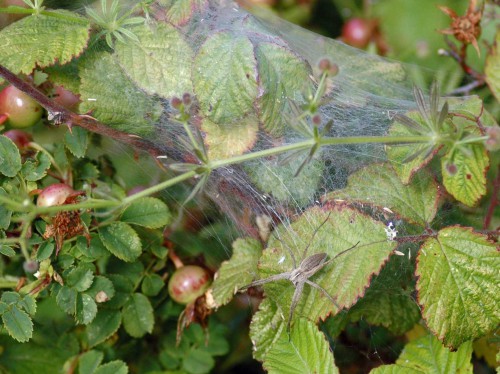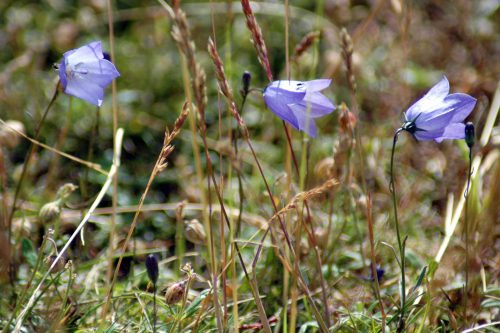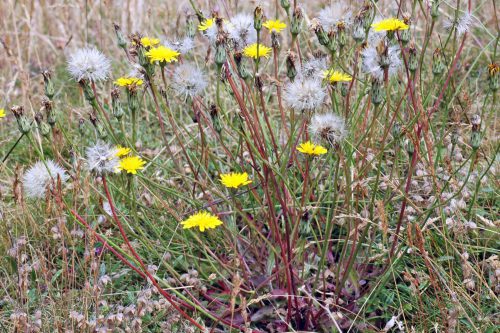Tags
dark green fritillary, flowering in July, Gatekeeper, Large Skipper, Meadow Brown, Ringlet, Volucella pellucens
July 7th – BRYN EURYN
Another hot sunny day. Not my idea of perfect walking weather, but I wanted to see how the hill, or rather its wildlife was holding up under the scorching weather, in particular hoping there would be butterflies.
It was pleasantly cooler inside the woods, but the ground was bone dry, hard and at this lower end of the path scattered with shed Laurel leaves, often a sign the plants are short of water.
I stopped at the small scrubby patch, often an insect hot-spot. Hot it was, but not with aerial activity. The nettles have flowered and are beginning to set seed and I noticed many of their leaves have been ravaged by insects. That set me thinking about the battles going on all around me between plants and their attackers and some of the other roles that leaves play.
I like to see eaten leaves as it’s a sure sign there are insects about, but of course plants need their leaves to supply them with food, so many do what they can to preserve them. Nettles have particularly aggressive defences; as those having had painful encounters with them will testify. They’re not aimed at us specifically of course, rather at grazing animals. They have stinging hairs, every one tipped with a tiny glassy needle that breaks off at the slightest touch that is sharp enough to cut skin; simultaneously poison is squirted into the wound from a small chamber at the base of each hair. Ouch! Even nibbling rabbits avoid them as they have sensitive noses and find the sting as unpleasant as we do. Despite this, nettles are the favoured food of such insects as the caterpillars of the Small Tortoiseshell and Red Admiral butterflies: they simply chomp through the safe juicy parts of the leaf, going around the dangerous stings, leaving them neatly in place.
Nearby a more pacific Wild Privet shrub is blossoming. Harmless in itself, but spiders have built webs over their fragrant blossoms in hope of capturing unsuspecting nectar-seeking insects.
Sycamore leaves are already freckled with Tarspot-Rhytisma acerinum. Although it occurs on other trees too, including Willow and Eucalyptus, it is generally referred to as Sycamore Tarspot and by this time of the year it’s practically impossible to find a Sycamore tree without it. This common and widespread fungus doesn’t look pretty, but doesn’t seem to adversely affect the trees it afflicts. Looking at Tarspot I then noticed a leaf that was curled at an edge. I have no idea what had accomplished this neatly rolled cylinder, clearly some species of insect at some stage of its life, but it impressed me greatly.
The structure is tightly rolled, like a small cigar, secured along the long edge and open at both ends. There are ‘blisters’ on the leaf too, so I wondered if there may be a connection?
Leaves make perfect landing and resting pads for butterflies too. This bramble leaf had served as such for a Green-veined White butterfly that took off just as I’d focussed on it! You can just see it rocketing out of the top of the photograph.
A Speckled Wood was more obliging, pausing on an ivy leaf at ground level.
Another spider’s web, this time utilising an Ash leaf.
WOODLAND TRAIL
Close to the junction of my Woodland Path with the Reserve’s Woodland Trail there are a few plants of Hogweed flowering. It was devoid of much insect interest at this time – occupied by just one feasting Eristalis sp. hoverfly. (I’m fairly sure it was Eristalis pertinax, but its diagnostic yellow tarsi were sunk into the flower petals.)
Hogweed has impressively large and interestingly-shaped leaves; this one was showing signs of having been nibbled and there are aphids dotted around on its surface. These plants often play host to great colonies of aphids that pierce the veins of its stems and leaves to feast on its sap. The aphids then attract insects that eat them, such as ladybirds.
Away from the peaceful confines of the shady wood and out onto the wider more open track I was soon distracted by insect activity. There’s not much about at the moment in the way of wildflowers, so what there is is in high demand. Wood Sage is both still flowering and beginning to set seed. The remaining little flowers of the plants close by were being visited by busy little Carder bees.
There are a whole host of different bramble species, which is possibly what accounts for them flowering and fruiting at slightly different times; a mercy at this time of year for insects seeking nectar and pollen.
Many bramble bushes are down to their last few flowers and are busy setting fruits. They may not come to much if we don’t get rain to swell them soon.
The enormous bramble here at the side of the track was positively frantic with insects this early afternoon. Hot sunny weather makes capturing images of insects tricky, they zoom around at high speed and bright sunlight reflects off shiny wings, bodies and white flowers. I saw more species here than I could catch, including a Red Admiral, Meadow Brown and Gatekeeper butterflies, Tree and Buff-tailed Bumblebees, Carder Bees and a few hoverflies. I managed to get a snap of a Honeybee, looking rather worn,
and an always-impressive Great Pied Hoverfly – Volucella pellucens
I would happily have stayed here for longer, but out in the open it was way too hot to stand in the blazing sun! Moving on along the trail there were very few flowers, some of the last are of Tutsan, but that too is also developing berries.
It’s unusual to see a Meadow Brown butterfly out in the open resting up on a leaf, especially opening up its wings to reveal its upper wings, but I think this one had not long emerged as it was still slightly crumpled. It may well have been a female as males tend to be a darker brown and may not have the orange patch.
It was quite a relief to get back into the shade.
Another new, still-crumpled butterfly caught my eye; this one a Large White.
MEADOW
With no hint of a breeze to stir the air it felt even hotter out in the open meadow. The thin soil was baked hard, the grass browned to a crisp. There are some green stems amongst it; there’s some Knapweed, its few flower buds small and tightly clenched closed.
Goat’s Beard has kept some leaves, and green stems support its lovely big globular seedheads, or clocks. There are tiny yellow dots of a hawkweed/hawkbit in there too.
A lovely big patch of Lady’s Bedstraw grows under a network of collapsed grass stems. It too has retained surprisingly green stems and leaves.

More Meadow Browns were doing what Meadow Browns do – that is flitting about amongst the long grass stems and landing in line with a grass stem that renders them barely visible.
Two very small dark ones were feeding on a single plant of flowering Ragwort.
LOWER HILLSIDE/WOODLAND EDGE
Too hot to consider hiking over the summit of the hill and down again to make a proper circuit, I got to the bottom of the hill by cutting back into the woods to reach the bottom of the Summit Trail. It was baking hot here too and although this is the cooler North side of the Bryn, it too is largely brown and very dry. I was surprised to spot a bird out here, hopping around in the grass and not too bothered by me watching it. I only saw it from the back, but could tell it was a young Mistle Thrush.
Greenery here is that of brambles, young trees, some grass and another stand of Rosebay Willowherb.
Knapweed is faring better here than in the small meadow and the first of its flowers are opening. Open flowers are sparse though and in high demand. Where 6-spot Burnet Moths lay claim to a flowerhead they settle in for a good long time and are reluctant to share.
I was here hoping to see a Dark Green Fritillary, but on first sight of the dryness and lack of flowers, didn’t have much hope. Then lo and behold I suddenly spotted a large fast-flying butterfly head for the very Knapweed occupied by a Burnet Moth. It tried to land but the moth denied it access and it shot off again. Fortunately it spotted an unoccupied flower nearby and settled, though only briefly before setting off again.
This part of the hillside, covered with long grass, brambles, gorse and pitted with rabbit holes is definitely off-limits for walking through, so no chasing butterflies! Best to stick to the few narrow tracks and hope something may cross your path. I did get a couple more glimpses of this gorgeous insect, but no more photo opportunities. I’m happy they are there and hope that there is more than one.
Last evening’s weather forecast promised sea mist over the Irish Sea and so it has come to pass. The whole landscape, including the Little Orme was veiled by it. It didn’t seem to being having much effect on the land temperature though.
Peering around for the fritillary I did spot some Skipper butterflies. Several Small Skippers living up to their name, skipping through the grass and a single male Large Skipper that kindly settled momentarily to pose on a grass seedhead.
And more luck as a Ringlet settled on a bramble flower. It didn’t settle for long either as it was dive-bombed by Bumblebees.
Time to get out of the sun. A passing glance at a Hazel tree on the woodland edge revealed a little bunch of ripening nuts, surprisingly not eaten yet by squirrels, and then a lovely fresh-looking Gatekeeper.
Back into the meadow on a different track I spotted the silken tent of a Nursery Web Spider, but no sign of its weaver.
Then a tiny flutter of a butterfly; a Brown Argus.
WOODLAND PATH
On my short-cut track back home, the sound of loud screeching drew my attention to a family of Jays up in the treetops; three together. One flew off, so I think it may have been two young ones demanding attention from a parent. One of those left in the tree wasn’t too happy though, you can see it has its crest raised.
Such pretty birds and a good note, albeit a loud one, to end a walk on.
















































































